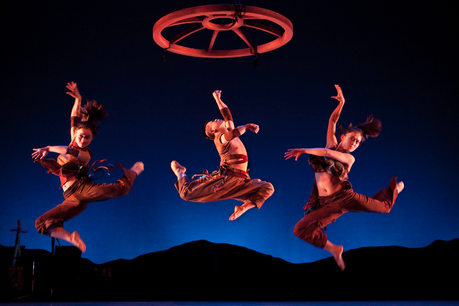Tono: infusing physicality with spirit

Tono: A Red Sky Production is an aesthetically satisfying, dynamic piece of performance that explores the relationships between Aboriginal cultures from opposite ends of the earth, fusing modern dance, North American plains culture and Mongolian traditions.
Tono takes inspiration from shamanic horse cultures, and the result is a strong physical geometry expressive of strong spirit. Full body movements and rhythmic foot stomping are accompanied by throat singing, Mongolian long-song, and the music of the horse-head violin. These otherworldly melodies are grounded by the percussive sounds of xylophone, gongs and hand cymbals. Startling accents come from one unusual instrument – a piece of flexible metal that when struck sounds like a whip-crack or breaking thunder.
Members of Red Sky have toured from Singapore to Calgary and points in between, and it shows in their work, which is highly polished and impeccably timed. The work has a distinct vocabulary, a combination of horse-like gestures – neat-stepping footwork, fists held like hooves, tossing heads, powerful shoulders and high kicks – and more muscular abstractions: handstands that become full back-bends, shoulder rolls, framed-out chests, figures that spin on their knees. Motions emphasize flexibility, speed, and strength. While the choreography is based in a particular set of movements, performers explore a range of variations within their chosen vocabulary. The dancers' configurations on stage is equally diverse: ensembles give way to duets, male-female pairs break apart into separate genders, and groups evaporate from the stage, leaving room for solo performers. The aesthetic drive behind Tono is, if not exhaustive, very thorough.
Above all, Tono celebrates beauty and power. Showcasing the virtuosity of the dancers, it brings traditions together in a rich blend of contrasting, dramatic forms of movement. In some respects it is a “safe” performance, easy to love for its impressive multi-cultural aesthetic and complex feats of strength. Yet while it undoubtedly emphasizes skill, a subtle sense of spiritual exploration underpins Tono. Speaking to some of the symbolism in the work in a CBC interview, co-choreographer and director Sandra Laronde says that “when the shaman dreams, they often dream upside down, whereas normal people dream right-side up.” Even without this foreknowledge, there is a clear emotional contrast between the sharp percussive movements in Tono and the round, inverted contortions that are used as counterpoint. By interweaving these styles, Tono builds an interplay between action and contemplation, infusing physicality with spirit.
The quiet spiritual core of the work comes to the fore in the final movement. Having paid homage to strength in nature, to wildness, freedom, and elemental majesty, Tono begins to question the origins of life. Dancers enter from the wings making stylized stepping motions, their swift feet mimicking a stampede. One man drags a long velvet drape behind him in an improvised travois, pulling a heavy bundle across the stage. Left behind as the dancers exit, this odd-shaped burden is revealed to be human – two figures wrapped in gauzy cloth. Evocative of an insect egg or some embryonic spirit, the figures fight to be free of each other, threatening to break through the skin of their womb, then embrace, huddling in its confines. Their contortions are accompanied by the soaring melancholy voice of a male singer. One figure finally emerges, her arms and legs straining, but her head remains wrapped in cloth and she drags the body of her unborn companion across the floor.
It is a strange and painful scene, critically important to the piece. It grounds the aesthetics of Tono in something more profound, suggesting that beauty and majesty come at a cost. Strength is not accidental, it evolves out of striving, emerging from the struggle to survive in a harsh environment. Tono builds slowly to this climactic point, and ends abruptly: the immobile form of the second figure is left poignantly alone on stage, a testament to the toll of survival. Then, a brief coda: sharp insistent drums thud like a heartbeat, a lone dancer enters, his chest heaving, and as if cued by his actions, the abandoned figure leaps from the floor. It is a strong ending. By closing on this note, the creators of Tono allow the audience to walk away with complex feelings, still touched by the melancholy of the earlier scene, but alive with potential energy.
For those interested in background on Tono, some references:



